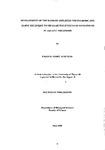DEVELOPMENT OF THE RANDOM AMPLIFIED POLYMORPHIC DNA (RAPD) TECHNIQUE TO MEASURE THE EFFECTS OF GENOTOXINSIN AQUATIC ORGANISMS
| dc.contributor.author | ATIENZAR, FRANCK ANDRE | |
| dc.contributor.other | School of Biological and Marine Sciences | en_US |
| dc.date.accessioned | 2013-09-16T12:02:11Z | |
| dc.date.available | 2013-09-16T12:02:11Z | |
| dc.date.issued | 2000 | |
| dc.identifier | NOT AVAILABLE | en_US |
| dc.identifier.uri | http://hdl.handle.net/10026.1/1757 | |
| dc.description.abstract |
Studies were undertaken to evaluate the potential of random amplified polymorphic DNA (RAPD) to detect DNA effects (including DNA damage and mutations) in aquatic invertebrates, following their exposure to a variety of environmental contaminants under laboratory conditions. After rigorous optimisation of the RAPD method, the protocol, which used a high annealing temperature (50"C for 10-mer primers), was found to generate good-quality DNA profiles from groups of organisms belonging to the bacterial, plant and animal kingdoms. The RAPD method was initially used to detect benzo(a)pyrene [B(a)P] and copper-induced DNA effects in the water flea Daphnia magna and ultraviolet-mediated DNA effects in the marine alga Palmaria palmata. The results clearly showed that changes occurred in RAPD profiles obtained from the exposed populations when compared to controls. In these studies, the effect of the genotoxins at higher levels of biological organisation (e.g. Darwinian parameters and/or fitness parameters) were also investigated and were compared with genomic DNA template stability (GTS), a qualitative index representing clear changes in panems compared to control RAPD profiles. The results from these experiments revealed that GTS could be more sensitive than growth parameters and showed at least equal or even greater sensitivity than other measures of fitness. Changes in RAPD profiles were believed to be the result of DNA effects, namely adduct formation, DNA breakage, oxidative damage and mutations and possibly other effects (e.g. variation in gene expression). Nevertheless, the nature and amount of DNA effects could only be speculated because diverse events may induce the same category of changes (i.e. variation in band intensity, appearance of bands, and disappearance of amplicons) in RAPD patterns. Further studies confirmed that RAPD had the potential to qualitatively detect oestrogen and xeno-oestrogen -induced DNA effects in barnacles. Additional experiments emphasised that oxygen radicals and variation in gene expression may induce significant changes in RAPD profiles. To further understand the effects of DNA lesions and mutations on RAPD patterns, individual types of DNA damage were created in vitro. The results clearly indicated that BaP DNA adducts, DNA photoproducts. and DNA breakages had significant effects on RAPD profiles but that diverse types of DNA damage may induce the same category of changes in RAPD patterns which render the interpretation of the results difficult. It was also concluded that mutations could be detected provided they do not arise in a random fashion. Finally, an attempt was made to determine the kinetics of DNA damage and DNA repair and whether changes in patterns obtained from B(a)P exposed Daphnia magna could be transmitted to successive generations. This strategy was developed to distinguish between mutations and DNA damage. The results showed that some bands obtained from the exposed populations were transmitted to the first and/or second generation but not to the third. It was concluded that the transmission of modified genetic material to the offspring was more likely to be the result of large genomic rearrangements and/or base methylation (epigenetic processes) rather than point mutations. In conclusion, the results presented in this research project show the potential of the RAPD assay as a useful method for the qualitative assessment of DNA effects including genotoxicity and changes in gene expression. The main advantage of this technique is that it can be applied to any species without requiring any information about the nucleotide sequence. In the field of ecogenotoxicology, its main advantage lies in its sensitivity and speed to detect a wide range of DNA damage including DNA breakage, DNA adducts, oxidative damage as well as mutations (including point mutations and large rearrangements). On the other hand, RAPD only allows a qualitative assessment of the DNA effects and the nature of the changes occurring in profiles can only be speculated. Finally, a great deal of further experimentation and validation are required in order to assess the applicability of the technique to a variety of other species and pollutants, particularly under field conditions. | en_US |
| dc.language.iso | en | en_US |
| dc.publisher | University of Plymouth | en_US |
| dc.title | DEVELOPMENT OF THE RANDOM AMPLIFIED POLYMORPHIC DNA (RAPD) TECHNIQUE TO MEASURE THE EFFECTS OF GENOTOXINSIN AQUATIC ORGANISMS | en_US |
| dc.type | Thesis | |
| plymouth.version | Full version | en_US |
| dc.identifier.doi | http://dx.doi.org/10.24382/3670 | |
| dc.identifier.doi | http://dx.doi.org/10.24382/3670 |
Files in this item
This item appears in the following Collection(s)
-
01 Research Theses Main Collection
Research Theses Main


